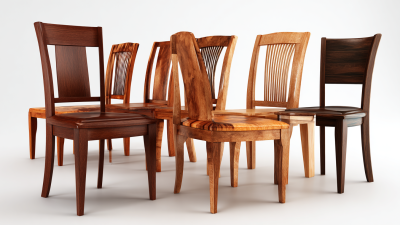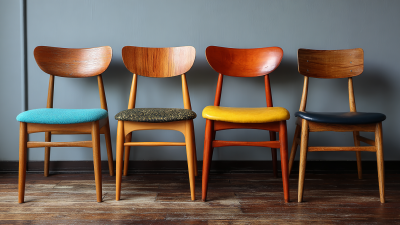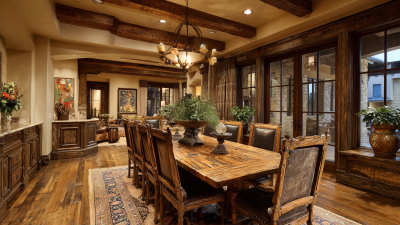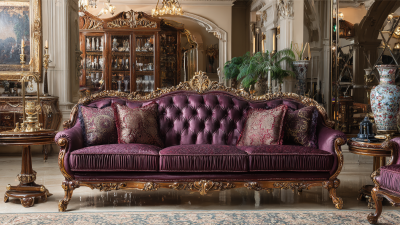
Blog
Top Strategies for Enhancing Your Wooden Desk Legs for Modern Interiors
In the evolving landscape of modern interior design, the appeal of minimalism and functionality has brought a renewed focus on furniture details, particularly on components such as wooden desk legs. According to a recent report by the American Wood Council, the demand for quality wood products has surged, with hardwood consumption increasing by over 20% in the last five years. This rise highlights not just a trend towards sustainable materials, but also underscores the aesthetic versatility that wooden desk legs can offer. As homeowners and designers alike seek to create spaces that reflect both style and practicality, enhancing these often-overlooked structural elements can significantly elevate the overall ambiance of a workspace. In this blog, we will explore top strategies to modernize your wooden desk legs, transforming them into striking focal points that align with contemporary interior aesthetics.

Top 5 Materials for Upgrading Wooden Desk Legs in Modern Workspaces
When it comes to modern workspaces, the material of your wooden desk legs can significantly influence both aesthetic appeal and functionality. Upgrading your desk legs can transform your home office from mundane to magnificent. Here are the top five materials to consider for enhancing wooden desk legs.
First on the list is metal, which adds a contemporary edge and excellent durability to your furniture. Steel or aluminum legs can create a striking contrast with wooden tops, bringing a fresh feel to any working environment. Next, incorporating glass elements can give the illusion of space and lightness, making it an excellent choice for smaller areas. Glass legs paired with a wooden surface create a beautiful blend of natural and modern materials.
Another impressive option is concrete, which conveys a robust, industrial vibe that resonates deeply in modern interior design. Concrete legs can anchor rich wooden tops beautifully, enhancing the overall visual impact. Finally, bamboo presents a sustainable choice that embodies a sleek aesthetic while being eco-friendly. Its lightweight and sturdy nature make it an ideal candidate for upgrading your workspace. With these materials, elevating your wooden desk legs can lead to a workplace that is not only functional but also aesthetically pleasing.

A Comparative Analysis of Finishing Techniques for Wooden Desk Legs
In modern interiors, the aesthetic appeal of wooden desk legs can significantly influence the overall ambiance of a room. To enhance their visual appeal and durability, various finishing techniques are available for wooden desk legs. Techniques such as staining, varnishing, and oiling not only protect the wood from wear and tear but also enrich its natural grains, adding character to any space. Staining can create a bolder look, while varnishing offers a high-gloss finish that reflects light beautifully, making the desk an attractive focal point.
Interestingly, recent innovations in furniture design highlight the versatility and potential of alternative materials. A company has developed “paper furniture” that utilizes specially engineered paper tubes as desk legs, capable of supporting substantial weight—up to one ton. This sustainable choice not only conserves around 70% of wood resources but also demonstrates that furniture can be lightweight without compromising strength or aesthetics. These advancements challenge traditional views on materials, encouraging a shift towards more eco-friendly finishes and structures in modern interiors. As homeowners seek contemporary designs, exploring finishing techniques alongside innovative materials will play a crucial role in developing functional and stylish workspaces.
Exploring Design Styles: Traditional vs. Contemporary Wooden Desk Legs
The choice between traditional and contemporary wooden desk legs can significantly impact the aesthetic appeal and functionality of modern interiors. According to a recent industry report by Statista, the market for contemporary furniture has seen a steady growth rate of 5.2% annually, indicating a shift towards streamlined designs and minimalist aesthetics that resonate with younger consumers. Contemporary wooden desk legs often feature sleek lines and smooth finishes, making them ideal for open spaces that prioritize light and airiness.
Conversely, traditional wooden desk legs evoke a sense of timelessness and craftsmanship, appealing to those who value historical styles. A survey by the American Home Furnishings Alliance found that 60% of consumers prefer furniture that reflects classic design elements, such as intricate carvings and rich stains. Traditional desk legs, such as turned or cabriole styles, lend warmth and character to an office space, particularly when paired with complementary decor. By understanding these contrasting design styles, homeowners can make informed decisions that enhance their interiors while accommodating personal tastes and functional needs.
Top Strategies for Enhancing Your Wooden Desk Legs for Modern Interiors
| Design Style | Material Type | Color Options | Finish Type | Elevation Techniques |
|---|---|---|---|---|
| Traditional | Solid Wood | Brown, Dark Walnut | Matte | Carved details |
| Contemporary | Plywood | White, Grey | Glossy | Floating design |
| Rustic | Reclaimed Wood | Natural, Distressed | Oiled | Raw texture |
| Minimalist | Bamboo | Black, White | Satin | Streamlined |
| Industrial | Metal & Wood | Metallic, Rustic Brown | Rusted | Support brackets |
Cost-Effectiveness of DIY vs. Professional Enhancements for Wooden Desks
When it comes to enhancing wooden desk legs for modern interiors, one of the primary considerations is the cost-effectiveness of DIY solutions compared to professional enhancements. According to a report by the Home Improvement Research Institute, DIY projects can save homeowners up to 40% on costs when compared to hiring professionals. This is particularly relevant for simple enhancements like staining, painting, or applying protective finishes, which can be easily accomplished with basic tools and a little bit of time.
However, it’s essential to weigh the investment of time and skill against potential benefits. A survey by Angie's List indicates that while DIY projects are typically less expensive, they may lack the finesse that professional services offer. Professional enhancement can cost 60-70% more, but it can also yield a higher quality finish and durable results that DIY approaches sometimes cannot achieve. Homeowners must carefully assess their budget, the complexity of the enhancement, and their own skill level before deciding which route to pursue for their wooden desk legs.
Cost-Effectiveness of DIY vs. Professional Enhancements for Wooden Desks
Durability Ratings: Comparing Treatments for Wooden Desk Legs in Modern Interiors
When it comes to enhancing the durability of wooden desk legs in modern interiors, choosing the right treatment is essential. According to a report by the Wood Furniture Manufacturers Association, untreated wood can suffer from moisture absorption, leading to warping and degradation over time. In contrast, treatments such as polyurethane and varnish provide a robust barrier against environmental factors, with durability ratings indicating that these finishes can extend the lifespan of wooden surfaces by up to 50%.

Moreover, the American Society for Testing and Materials (ASTM) has established standards for wood treatment methods, revealing that wood legs treated with water-resistant stains show a superior resistance to wear and tear, with abrasion resistance ratings nearly three times higher than their untreated counterparts. Combining these treatments not only enhances durability but also enriches the aesthetic appeal of modern interiors, allowing homeowners to maintain their design integrity without sacrificing functionality. Exploring these treatments provides a strategic avenue for anyone looking to preserve their wooden furniture investments effectively.
Related Posts
-

The Definitive Handbook to Choosing Modernist Dining Chairs for Every Home
-

How to Choose the Perfect Wood Dining Chairs for Your Home Based on Expert Recommendations
-

7 Reasons Why Furniture Online Shopping is the Future of Global Purchasing
-

Choosing the Right Manufacturer for the Best Modernist Dining Chairs a Comprehensive Guide
-

The Ultimate Guide to Choosing the Perfect Solid Wood Dining Room Table for Your Home
-

Solutions for Elevating Your Space with the Best Luxury Furniture
